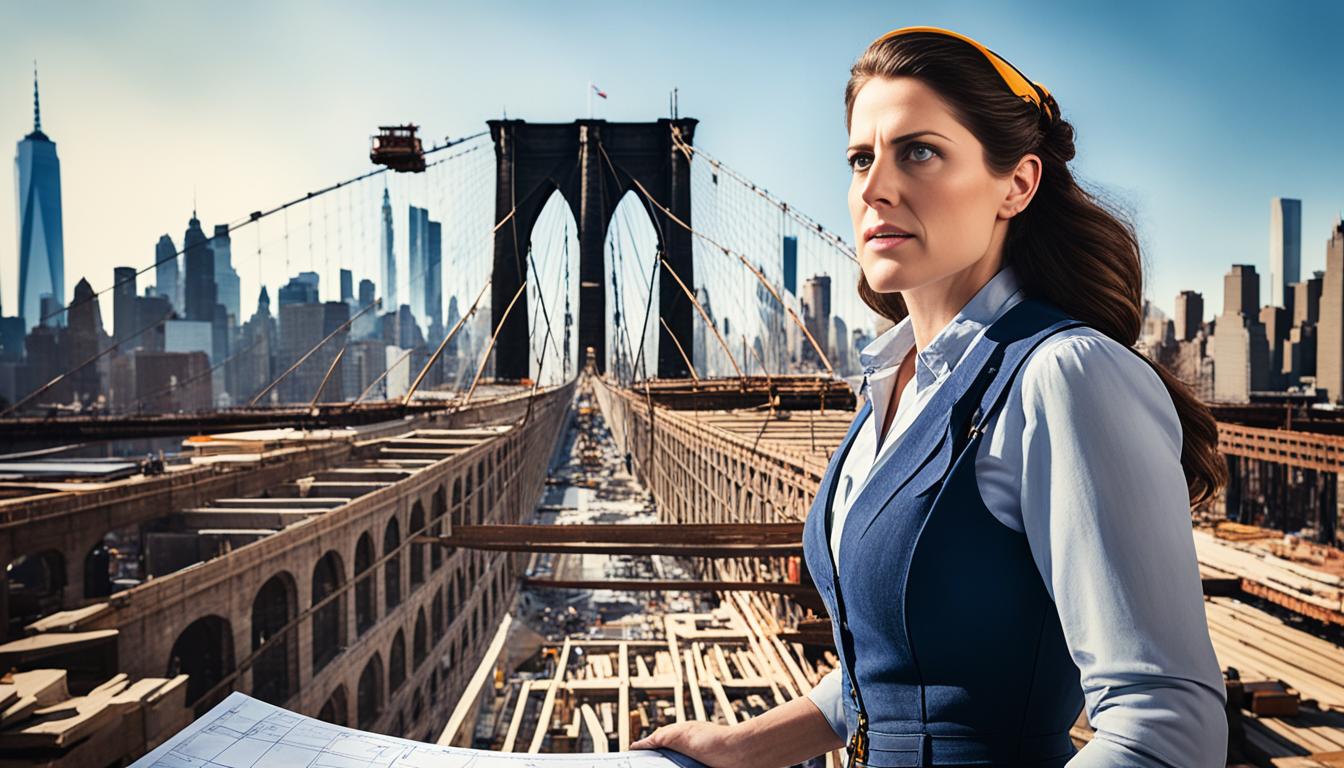The Brooklyn Bridge is one of New York City’s most iconic landmarks, but few know the story of the remarkable woman who played a crucial role in its construction. Emily Warren Roebling, a pioneering female engineer, took charge of the bridge’s construction when her husband, Washington Roebling, fell ill.
Born in 1843 in Cold Spring, New York, Emily was educated at a convent school in Washington, D.C. She met Washington Roebling, the son of Brooklyn Bridge designer John A. Roebling, during the American Civil War. The couple married in 1865 and traveled to Europe to study the use of caissons in bridge construction.
In 1869, Washington assumed the role of chief engineer after his father’s death, but he developed severe decompression sickness, leaving him bedridden. Emily Warren Roebling stepped in to oversee the day-to-day construction and project management of the bridge, becoming a trailblazer for women in engineering.
Key Takeaways
- Emily Warren Roebling played a vital role in the construction of the Brooklyn Bridge.
- She took charge of the project when her husband, Washington Roebling, fell ill.
- Emily was a pioneering female engineer in a male-dominated field.
- She oversaw the day-to-day construction and project management of the bridge.
- Emily Warren Roebling’s contribution to the Brooklyn Bridge is a testament to her resilience and leadership.
Emily Warren Roebling: The Unlikely Heroine of the Brooklyn Bridge
In the annals of American history, few stories are as inspiring as that of Emily Warren Roebling, the remarkable female engineer who played a pivotal role in the Brooklyn Bridge construction. Born in 1843, Emily was not content with the traditional gender roles of her time. Instead, she pursued education and developed a keen interest in mathematics and science, laying the foundation for her future contributions to the field of women in STEM.
Emily’s journey to becoming a central figure in the Brooklyn Bridge project began when she married Washington Roebling, the chief engineer of the bridge. However, tragedy struck when Washington fell ill with caisson disease, a debilitating condition caused by the high-pressure environment of the bridge’s underwater foundations. With her husband bedridden, Emily stepped up to the challenge and assumed a leadership role in the bridge’s construction.

Through her husband’s teachings and her own relentless study, Emily developed a deep understanding of engineering principles, including strength of materials, stress analysis, cable construction, and calculating catenary curves. Her expertise was so extensive that some believed she had effectively taken on the role of chief engineer herself. Emily’s dedication and knowledge were instrumental in overcoming the numerous obstacles that threatened to derail the Brooklyn Bridge project.
As a liaison between her husband and the engineering team, Emily ensured that Washington’s vision for the bridge was realized. She communicated his instructions, supervised construction, and made critical decisions when necessary. Moreover, Emily served as a spokeswoman for her husband, reassuring officials and the public of his ability to manage the project despite his illness. Her unwavering confidence and leadership were essential in maintaining the project’s momentum.
On the momentous day of the Brooklyn Bridge’s opening in May 1883, Emily Warren Roebling was given the honor of being the first person to cross the bridge by carriage. In a symbolic gesture of victory, she carried a rooster with her, signifying the triumph over adversity that she and the entire project team had achieved. Emily’s contributions to the Brooklyn Bridge construction forever changed the perception of women’s roles in engineering and society as a whole.
Overcoming Challenges and Adversity
The construction of the Brooklyn Bridge was a monumental undertaking that faced numerous challenges, both personal and technical. Washington Roebling, the chief engineer, suffered from a severe case of decompression sickness, also known as caisson disease, which left him bedridden and unable to directly oversee the project. In the face of this adversity, his wife, Emily Warren Roebling, stepped up to fill the role despite the prevalent gender discrimination of the time.
As a woman in a male-dominated field, Emily faced skepticism and discrimination, but she proved her capabilities through her extensive knowledge and effective management. She played a crucial role in the suspension bridge engineering process, ensuring that the project stayed on track despite her husband’s illness.
The Brooklyn Bridge was a pioneering project, as it was the longest suspension bridge in the world at the time and the first to use steel cable construction. The Roeblings had to innovate and develop new engineering methods to overcome these technical challenges, as there were no existing structures to draw knowledge from. Their ingenuity and perseverance were essential in bringing the bridge to completion.
Emily Warren Roebling’s role in the construction of the Brooklyn Bridge was not only significant in terms of her personal triumph over adversity but also in breaking down gender barriers in the field of engineering. Her contributions to the project, despite the challenges she faced, serve as an inspiration to women in STEM fields even today.
Brooklyn Bridge’s Female Engineer: Emily Warren Roebling’s Legacy
Emily Warren Roebling’s contributions to the Brooklyn Bridge were not fully recognized during her lifetime, but her legacy as a pioneering woman in engineering has endured. After the bridge’s completion, Roebling became active in various social and philanthropic organizations, including the Daughters of the American Revolution and the Relief Society during the Spanish-American War. She also advocated for women’s rights, penning an influential essay titled “A Wife’s Disabilities” in 1899, in which she argued against discriminatory practices targeting women.
In 2018, The New York Times published a belated obituary for Roebling, acknowledging her crucial role in the construction of the Brooklyn Bridge and honoring her as a trailblazing female engineer. This historical recognition, albeit delayed, underscores the significance of Roebling’s achievements in a field dominated by men during her time. Her story serves as an inspiration to aspiring women in engineering and other STEM fields, demonstrating that determination and skill can overcome societal barriers and gender bias.
Today, the Brooklyn Bridge stands as a testament to Emily Warren Roebling’s legacy. Her unwavering dedication, technical expertise, and leadership in the face of adversity were instrumental in the successful completion of one of the most iconic structures in New York City. As we celebrate the accomplishments of pioneering women in engineering like Roebling, we must continue to strive for greater gender equality and recognition of women’s contributions in all fields.

Leave a Reply